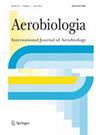Storms facilitate airborne DNA from leaf fragments outside the main tree pollen season
Abstract
Bioaerosols are useful indicators of plant phenology and can demonstrate the impacts of climate change on both local and regional scales (e.g. pollen monitoring/flowering phenology). Analysing bioaerosols with eDNA approaches are becoming more popular to quantify the diversity of airborne plant environmental DNA (eDNA) and flowering season of plants and trees. Leaf abscission from broadleaved trees and other perennial species can also indicate the status of plant health in response to climate. This happens primarily during autumn in response to seasonal growth conditions and environmental factors, such as changing photoperiod and reduced temperatures. During this period biological material is released in larger quantities to the environment. Here, rural bioaerosol composition during late summer and autumn was captured by MiSEQ sequencing of the rRNA internal transcribed spacer 2 (ITS2) region, a common marker for taxonomic variation. Meteorological parameters were recorded from a proximal weather station. The composition of atmospheric taxa demonstrated that deciduous tree DNA forms part of the bioaerosol community during autumn and, for several common broadleaved tree species, atmospheric DNA abundance correlated to high wind events. This suggests that both flowering and autumn storms cause bioaerosols from deciduous trees that can be detected with eDNA approaches. This is an aspect that must be considered when eDNA methods are used to analyse either pollen or other fragments from trees.


 求助内容:
求助内容: 应助结果提醒方式:
应助结果提醒方式:


